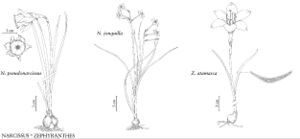Narcissus pseudonarcissus
Sp. Pl. 1: 289. 1753.
Bulbs ovoid, 3–5 × 2–3 cm, tunic pale-brown. Leaves 3–4; blade flat, 20–45 cm × 5–12 (–15) mm, glaucous. Inflorescences 1-flowered, 25–50 cm; spathe pale-brown, 2–3 cm, papery. Flowers fragrant; perianth white, 5–7 cm wide; perianth-tube 1.5–2 cm, tapering abruptly to base; distinct portions of tepals erect to spreading, yellow, often twisted, oblanceolate, 2.5–3.5 × 1–1.5 cm, apex acute; corona yellow, tubular, 30–35 × 15–25 mm, apex flared and ruffled; stamens uniseriate, exserted to ca. midlength of corona; style exserted 2–5 mm beyond anthers; pedicel 5–10 mm. 2n = 14.
Phenology: Flowering spring.
Habitat: Roadsides, fields, waste places
Elevation: 0–1000 m
Distribution
Introduced; B.C., Nfld. and Labr. (Nfld.), Ont., Ala., Ark., Conn., Ga., Ill., Ind., Ky., La., Md., Mass., Mich., Miss., Mo., N.J., N.Y., N.C., Ohio, Oreg., Pa., R.I., S.C., Tenn., Tex., Va., Wash., w Europe, expected naturalized elsewhere
Discussion
Narcissus pseudonarcissus is the most variable species in the genus and includes many elements that sometimes have been recognized as separate species (e.g., H. W. Pugsley 1933). An old cultivated variety, “Telemonius Plenus,” with highly doubled flowers, commonly persists, although it does not reseed. Natural hybrids between N. pseudonarcissus and N. poeticus (N. ×incomparabilis Miller) have 1-flowered inflorescences and yellow flowers with the corona about half as long as the distinct portions of the tepals. They are known to persist in Kentucky, Louisiana, Mississippi, New Jersey, New York, North Carolina, Oregon, Pennsylvania, Texas, and Virginia. Natural hybrids between N. pseudonarcissus and N. jonquilla (N. ×odorus Linnaeus) have 1–4-flowered inflorescences and bright yellow flowers with the corona one-half to three-fourths as long as the distinct portions of the tepals. They are known to persist in Louisiana, South Carolina, Texas, and Virginia.
Selected References
None.
Lower Taxa
"thicker" is not a number.
